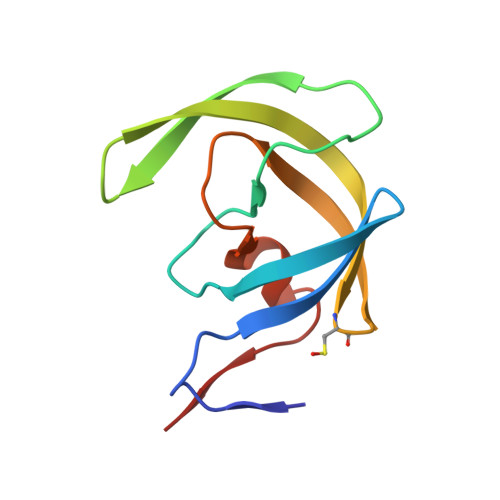On the role of the R configuration of the reaction-intermediate isostere in HIV-1 protease-inhibitor binding: X-ray structure at 2.0 A resolution.
Duskova, J., Dohnalek, J., Skalova, T., Petrokova, H., Vondrackova, E., Hradilek, M., Konvalinka, J., Soucek, M., Brynda, J., Fabry, M., Sedlacek, J., Hasek, J.(2006) Acta Crystallogr D Biol Crystallogr 62: 489-497
- PubMed: 16627941
- DOI: https://doi.org/10.1107/S0907444906006718
- Primary Citation of Related Structures:
1ZSF, 1ZSR - PubMed Abstract:
Peptidomimetic inhibitors of human immunodeficiency virus-1 protease are successful lead substances for the development of virostatic drugs against HIV as the causative agent of acquired immunodeficiency syndrome (AIDS). The hydroxyethylamine isostere of the proteolytic cleavage intermediate provides a suitable replacement for the peptide bond. A series of acyclic pseudopeptide inhibitors with the hydroxyethylamine isostere varying in chiral carbon configuration and P'2 residue type were structurally analysed by single-crystal X-ray crystallography. The compounds inhibit HIV protease with subnanomolar inhibition constants and block viral replication in tissue cultures. Here, the structure of such a complex with the R configuration of the isosteric group (PDB code 1zsf) is presented together with newly available synchrotron data for a complex with the S stereoisomer of the inhibitor (PDB code 1zsr). Comparison of the structure and binding with other complexes of HIV-1 protease and similar inhibitors contributes to the understanding of how these molecules bind to the wild-type form of this enzyme. The hydroxy group of the R stereoisomer interacts with one of the catalytic aspartic acids by a short hydrogen bond with rather extreme geometry. The change of configuration of the chiral carbon bearing the hydroxyl from S to R does not influence the inhibition efficiency in this case.
Organizational Affiliation:
Institute of Macromolecular Chemistry, Academy of Sciences of the Czech Republic, Heyrovského nám. 2, 162 06 Praha 6, Czech Republic. duskova@imc.cas.cz
















